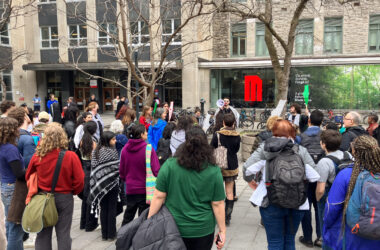Montrealers are driving less, according to a survey conducted by the Metropolitan Transport Agency (AMT).
For the first time in the survey’s 40-year history, the number of trips taken per car has decreased, despite an increase in the number of cars entering the city.
“The survey shows that the AMT’s work is paying off,” Martine Rouette, an AMT spokesperson, wrote in an email to the Tribune. “Despite the fast evolution of the automobile market, public transit is improving and citizens prefer to use it.”
Since 1970, the AMT has performed nine surveys on different modes of transportation. The latest results indicate that the use of cars has decreased by one per cent since 2003, while the use of public transport has risen by 15 per cent. Evidence suggests that 51 per cent of the daily trips into the city are work-related, and that the majority of these jobs are still located in the downtown area.
“What was found in the survey is very encouraging because it demonstrates that a large number of Montrealers are leaving their cars behind,” Rouette wrote. “The AMT and the [Montreal Transport Association] are working together to increase public transportation and decrease greenhouse gas emissions. So far, the results have been successful.”
According to Julie Boulet, the Quebec Minister of Transport, efforts to improve public transit by various provincial agencies have decreased car use.
The AMT is particularly responsible for the development of public transport in the Montreal Region and is directly linked to the Quebec Ministry of Transport. Although the ministry subsidizes the AMT, the agency administers this funding independently.
Though the ministry is the main organization responsible for transportation-related matters, it remains in close cooperation with its public and private partners to offer appropriate and functional transportation systems.
“[The result] is great because the efforts of the Ministry of Transport are not always evident. There are a lot of funds devoted annually by the minister to the AMT as well as to the STM to, for instance, expand the metro network or increase bus frequency, so this is a way to prove it,” said Mario St-Pierre, director of communications at Transport Quebec. “The minister finances a lot of organisms of this kind that are there to provide usable public transit.”
When asked about the results of the survey, Max Halparin, U3 Geography, speculated that improved public transit had made the difference.
“I suppose we are getting fed up with traffic and congestion and that public transit is actually a viable option in this city, especially for commuters,” he said.
But according to Halparin, the decrease in driving cannot be exclusively attributed to the work of the AMT.
“Transit can’t be successful on its own. What makes a place walkable, accessible, and livable without a car is planned surrounding, how we actually design spaces – I mean, the density and the mixture of land uses, and in addition to that there is a cultural factor.”








